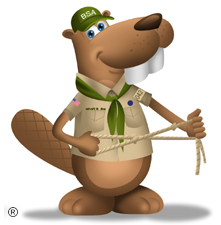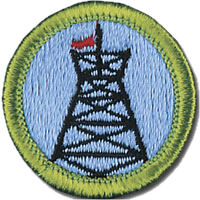Pioneering


Resources
- Pioneering Merit Badge Pamphlet
- Pioneering Merit Badge Class Preparation Page
- Pioneering Merit Badge Workbook
- Scoutmaster Bucky's Merit Badge Advancement Quick Reference
- Scoutmaster Bucky's Acknowledgement Form
Pioneering Requirements
Current Scouts BSA requirements
as of December 6, 2025
as of December 6, 2025
Note: All pioneering projects constructed for this merit badge must
comply with height standards as outlined in the Guide to Safe Scouting.
Counselors should also ensure that Scouts follow the
Leave No Trace Seven Principles and the Outdoor Code in their pioneering
projects. Just as hiking and camping without a trace are signs of expert
outdoorsmanship, protecting the environment is a mark of responsible
pioneering. Minimize impacts to the land.
1.
Do the following:
a.
Explain to your counselor the most likely hazards you might encounter
while participating in pioneering activities and what you should do to
anticipate, help prevent, mitigate, and respond to these hazards.
b.
Discuss the prevention of, and first-aid treatment for, injuries and
conditions that could occur while working on pioneering projects,
including rope splinters, rope burns, cuts, scratches, insect bites and
stings, hypothermia, dehydration, heat exhaustion, heatstroke, sunburn,
and falls.
2.
Do the following:
a.
Demonstrate the West Country method of whipping a rope.
b.
Demonstrate how to tie a rope tackle and the following knots: clove
hitch formed as two half hitches, clove hitch on a bight, butterfly
knot, roundturn with two half hitches, and rolling hitch.
c.
Demonstrate and explain when to use the following lashings: square,
diagonal, round, shear, tripod, and floor lashing.
3.
Do the following:
a.
Using square and tripod lashings from requirement 2(c), build a Tripod
Wash Station (or with your counselor's permission, another camp gadget
of your own design).
b.
Using rolling hitches or roundturns with two half hitches, and round
lashings from requirements 2(b) and 2(c), build a 15-foot Scout Stave
Flagpole (or with your counselor's permission, another camp gadget of
your own design).
c.
Using shear, square, and floor lashings, clove hitches on a bight, and
rope tackles from requirements 2(b) and 2(c), build a Simple Camp Table (or
with your counselor's permission, another camp gadget of your own
design).
4.
Explain the differences between synthetic ropes and natural-fiber ropes.
Discuss which types of rope are suitable for pioneering work and why.
Include the following in your discussion: breaking strength, safe working
loads, and the care and storage of rope.
5.
Explain the uses for the back splice, eye splice, and short splice. View a
demonstration on forming each splice.
6.
Using a rope-making device or machine, make a rope at least 6 feet long
consisting of three strands, each having three yarns. Whip the ends.
7.
Explain the importance of effectively anchoring a pioneering project.
Describe to your counselor the 3-2-1 anchoring system and the log-and-stake
anchoring system.
8.
Describe the lashings that are used when building a trestle, how the poles
are positioned, and how X braces contribute to the overall structural
integrity of a pioneering project.
9.
Working in a group, (or individually with the help of your counselor) build
a full size pioneering structure, using one of the following designs in
the Pioneering merit badge pamphlet:
- Double A-Frame Monkey Bridge
- Single A-Frame Bridge
- Single Trestle Bridge
- Single Lock Bridge
- 4x4 Square Climbing Tower
- Four Flag Gateway Tower
- Double Tripod Chippewa Kitchen
- Another type of structure approved in advance by your counselor